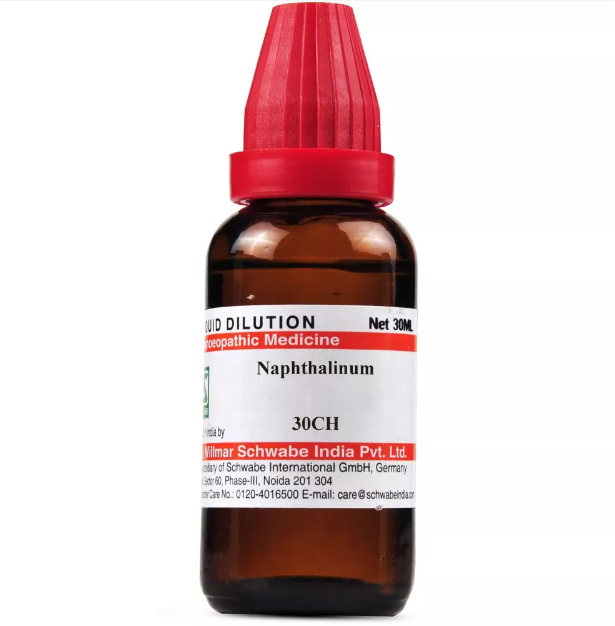NAPHTHALINUM 6C, 12C, 30C, 200C, 1M, 10M USES AND SYMPTOMS
 NAPHTHALINUM
NAPHTHALINUM
(A Chemical Compound From Coal-tar, Tar Camphor)
Naphtin.
Coryza, hay fever, phthisis pulmonalis, and gonorrhea respond well to this drug. Pyelonephritis. Irritation of the urinary system. Whooping cough.
Head: Appears stupefied by a narcotic. Restless. Pale face with a yellowish hue.
Eyes: Strong affinity for the eye. Causes retinal detachment, papillo-retinal infiltration; patchy deposits on the retina; amblyopia and subsequent amaurosis; sparkling synchisis; soft cataract. Exudation in the retina, choroid, and ciliary body. Cataract. Corneal opacity (leucoma).
Urinary: Irresistible urge. Red, swollen meatus and prepuce edema (balanitis). Black urine. Sharp pain down the penis. Bladder pain (cystitis). Terribly offensive decomposing ammoniacal urine.
Respiratory: Sneezing; inflamed, painful eyes; hot head. Hay fever. Spasmodic asthma, better in open air. Chest and stomach soreness; must loosen clothing. Dyspnea and sighing inspiration. Emphysema in the elderly with asthma. Whooping cough with long, continuous coughing fits, unable to breathe. Acute laryngo-tracheitis. Bronchitis with spasmodic element and tenacious expectoration and oppression (Cartier).
Skin: Dermatitis; itchy infiltration. Eruptions at the mouth corners and pigmentation around nails.
Relationship: Compare: Dros., Cor-r, Coc-c. Terpin-hydras. (whooping cough, hay asthma, and bronchial affections. 1-2 grain doses).
Non-homoeopathic Uses: For worms, especially pinworms, one-gram dose. Externally in skin diseases, five percent ointment.
Dose: Third trituration.
SYMPTOMS OF NAPHTHALINUM
Head:
Feels stupefied as if by a narcotic.
Restless, with a pale, yellowish hue to the face.
Eyes:
Significant impact on the eyes, causing retinal detachment, papillo-retinal infiltration, and patchy deposits on the retina.
May lead to amblyopia, amaurosis, sparkling synchisis, soft cataract, and exudation in the retina, choroid, and ciliary body.
Causes cataracts and corneal opacity (leucoma).
Urinary:
Irresistible urge to urinate.
Red, swollen meatus with edema of the prepuce (balanitis).
Black urine with a cutting pain down the penis.
Painful bladder (cystitis) with a strong, offensive odor of decomposing ammoniacal urine.
Respiratory:
Sneezing with inflamed, painful eyes and a hot head.
Hay fever and spasmodic asthma, better in open air.
Chest and stomach soreness, needing to loosen clothing.
Dyspnea, sighing inspiration, and emphysema in aged individuals with asthma.
Whooping cough with prolonged coughing fits, causing difficulty breathing.
Acute laryngo-tracheitis and bronchitis with spasmodic elements, tenacious expectoration, and oppression (Cartier).
Skin:
Dermatitis with itching infiltration.
Eruptions at mouth corners and pigmentation around nails.
Relationship:
Compare with Dros., Cor-r, Coc-c, Terpin-hydras (for whooping cough, hay asthma, and bronchial affections, in 1-2 grain doses).
Non-homoeopathic Uses:
For worms, especially pinworms, in one-gram doses.
Externally for skin diseases, as a five percent ointment.
selection of the potency
Individualization:
- Homeopathy is based on the principle of treating the individual, not just the disease. The unique symptoms and characteristics of the person are crucial in determining the most suitable potency.
Intensity of Symptoms:
- The intensity of the symptoms guides the choice of potency. If the symptoms are intense and acute, a lower potency (e.g., 6C, 30C) might be considered. For chronic conditions with less intensity, higher potencies (e.g., 200C, 1M) may be appropriate.
Sensitivity of the Patient:
- Some individuals are more sensitive to homeopathic remedies, while others may require higher potencies. The practitioner considers the patient’s sensitivity when selecting the potency.
Acute vs. Chronic Conditions:
- Lower potencies are often used for acute conditions, while higher potencies may be considered for chronic or long-standing issues.
Previous Response to Potencies:
- The patient’s response to previous homeopathic treatments helps guide the choice of potency. If a particular potency has been effective in the past, it may be repeated or adjusted as needed.
Vital Force and Susceptibility:
- Homeopathy views illness as a disturbance in the vital force. The practitioner assesses the patient’s overall vitality and susceptibility to determine the appropriate potency.
Aggravation or Amelioration:
- The direction of the symptom response (aggravation or amelioration) after taking a remedy can influence the choice of potency.
Miasmatic Considerations:
- In classical homeopathy, the concept of miasms (inherited disease tendencies) is considered. The practitioner take this into account when selecting the potency.
Practitioner Experience:
- The experience and preference of the homeopathic practitioner play a role. Some practitioners may have success with certain potencies based on their clinical experience.
SAFETY INFORMATION
- Do not exceed the recommended dose by physician
- Keep out of the reach of children
- Store in a cool dry place away from direct sunlight
- Maintain half an hour gap between food/drink/any other medicines and homoeopathic medicine
- Avoid any strong smell in the mouth while taking medicine e.g. camphor, garlic, onion, coffee, hing
Medicine images use for reference only selection of homeopathic medicine depends on the individual’s specific symptoms and overall constitution. Moreover, homeopathy is a holistic system of medicine that treats the individual as a whole. In addition to addressing the physical symptoms, it takes into account the emotional and mental state of the person. Consequently, it’s crucial to consult with a qualified homeopathic practitioner for personalized treatment.
The information provided on this website is intended solely for educational purposes. Always seek the advice of your physician or other qualified health provider.
